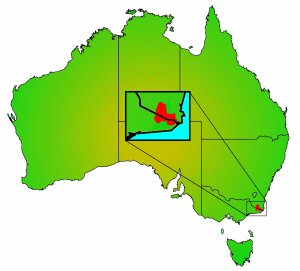Roundsnout galaxias facts for kids
Quick facts for kids Roundsnout galaxias |
|
|---|---|
| Conservation status | |
| Scientific classification | |
| Genus: |
Galaxias
|
| Species: |
terenasus
|
The roundsnout galaxias (scientific name: Galaxias terenasus) is a special type of freshwater fish. It belongs to the galaxias family and is part of a group called the Mountain Galaxias complex. You can find this fish living in Australia.
Contents
About the Roundsnout Galaxias
The roundsnout galaxias is quite unique among its relatives. It has the usual Galaxias body shape, which is long and tube-like with rounded fins. But this fish stands out because of its smaller size. Female roundsnout galaxias are usually bigger than males.
It also has a special color and pattern on its body. Its fins are thin, and its snout (nose area) looks rounded when you see it from the side. Its eyes are set high on its head. The fins along its back and belly are a bit fleshy at their base. The fins on its sides are medium-sized and shaped like paddles. Its tail fin has a moderate notch.
This fish usually grows to be about 45 to 55 mm (1.8 to 2.2 in) long. The biggest one ever recorded was 70 mm (2.8 in) (2.8 in).
Colors and Patterns
The roundsnout galaxias is mostly olive brown on its back and sides. This color also covers its head and snout. The lower part of its body is lighter, and its belly is silvery.
Its main color has a pattern of small, dark, and closely packed blotches. These are especially noticeable on its back, sides, head, and snout. Many of these dark blotches connect to form uneven vertical bars. Sometimes, a fine dark stippling (like tiny dots) can hide these markings. The gill covers are see-through and have a small gold spot. Its fins are clear or a see-through tan color, and its eyes are a coppery gold.
Where the Roundsnout Galaxias Lives
The roundsnout galaxias lives in the far eastern part of East Gippsland in Victoria. It also lives in the very southeast of New South Wales. You can find it in the middle parts of the Snowy, Cann, and Genoa river systems.
We don't have much old information about where this fish used to live. However, some were caught near Nimmitabel in 1914. Others were found near Bombala in 1938 and near Delegate in 1965-6. Scientists confirmed the fish were still in the Bombala and Church Creek areas in 2002-3.
Its Home: Habitat
The roundsnout galaxias usually lives in streams and rivers. These waterways can be from 1–12 m (3.3–39.4 ft) (3.3-39.4 ft) wide and 10–60 cm (3.9–23.6 in) (3.9-23.6 in) deep. The water is usually clear and flows slowly to medium fast. The deeper parts, called pools, can be from 0.2–1.8 m (0.66–5.91 ft) (0.7-5.9 ft) deep.
The areas around these streams are often lightly or heavily forested, providing shade. The fish mostly lives in pools, glides (smooth, flowing water), and riffles (shallow, fast-flowing water). It also uses smaller areas of still water that are backed up. The bottom of the stream is usually made of bedrock, large rocks, rounded stones, and gravel.
Inside the stream, the fish finds cover in rocks and woody debris (like fallen branches). There's also a small amount of aquatic plants, fallen leaves, undercut stream banks, and plants hanging over the water.
Life Cycle and Reproduction
The roundsnout galaxias spends its entire life cycle in freshwater. It shares its home with several other native species. These include longfin and shortfinned eels, River blackfish, common freshwater shrimp, East Gippsland spiny cray, variable spiny crayfish, and a native bivalve mollusc (a type of shellfish).
Sometimes, it also lives in water where non-native brown trout are found. However, scientists believe the roundsnout galaxias lives in different parts of the habitat than the trout. This means they don't compete directly for space or food.
We don't know the exact time when this fish lays its eggs (spawns). But scientists think it happens from spring to early summer. Female fish ready to lay eggs have been found with 220-240 small eggs. These eggs are about 1.2 mm (0.047 in) (0.047 in) wide. This small number of eggs means the species doesn't have many offspring at once.
Conservation Status
The roundsnout galaxias is an endangered fish. This means it is at high risk of disappearing forever. It is protected by the Victorian Flora and Fauna Guarantee Act 1988 in Australia.
Why This Fish Matters to Humans
Because of its small size and its endangered status, the roundsnout galaxias is not a fish that people try to catch for sport or food. It is important to protect it so it can continue to be a part of Australia's unique freshwater ecosystems.



